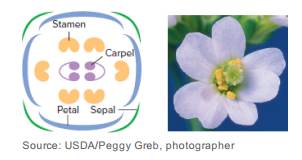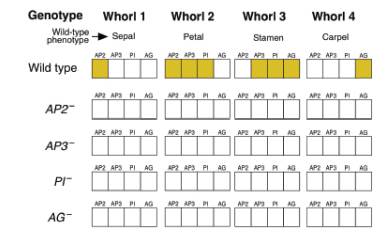
Concept explainers
In the plant Arabidopsis thaliana, every flower is constructed of four concentric whorls of modified leaves. The first whorl (whorl 1) consists of four green leaf-like sepals, whorl 2 is composed of four white petals, whorl 3 is made of six stamens bearing the pollen that houses the male gametes (sperm), and whorl 4 contains the two carpels, within which lie the ovules that hold the female gametes (eggs). As shown in the diagram that follows, a shorthand description of the wild-type flower pattern is: sepal, petal, stamen, carpel.

Scientists wanted to understand how this pattern of whorls arises. They generated Arabidopsis strains homozygous for randomly induced mutations and screened them for mutant flowers with an abnormal order or selection of floral organs. The interesting mutants identified fell into three phenotypic classes: (1) carpel, stamen, stamen, carpel; (2) sepal, sepal, carpel, carpel; (3) sepal, petal, petal, sepal.
The investigators found that all of the class 1 mutants were alleles of the same gene which they called APETELA2 (AP2). Class 2 mutants were alleles of either one of two genes, which were named APETELA3 (AP3) and PISTILLATA (PI). Finally, the class 3 mutants represented a single gene, AGAMOUS (AG). Molecular analysis showed that all four genes encode transcription factors.
Based on the
| a. | Complete the chart that follows to show how the model predicts the phenotype of flowers homozygous for mutations in each of the four genes. In the chart, the colored boxes represent genes that are expressed; the white boxes are genes that are not expressed. |
| b. | Scientists tested the flower patterning model with RNA in situ hybridization experiments using cDNA probes for each of the four genes. The goal was to see whether each gene’s mRNA was expressed in the precursor cells for each of the four whorls. What results would you predict with each probe on wild-type flowers? on AP2 mutants? on AG mutants? |
| c. | Another way the researchers tested their model for flower patterning was by making double mutants. What phenotypes does the model predict for each of the six double mutant combinations? [Hint: It will be helpful to expand the chart shown in part (a) for each possible double mutant.] |
| d. | Are the roles of the four genes described in this problem more similar to those of the segmentation genes or to those of the homeotic genes from Drosophila described in the text? |
Want to see the full answer?
Check out a sample textbook solution
Chapter 19 Solutions
Genetics: From Genes to Genomes
- A triploid plant has 18 chromosomes (i.e., 6 chromosomes perset). If we assume a gamete has an equal probability of receivingone or two copies of each of the six types of chromosome, whatare the odds of this plant producing a haploid or a diploid gamete?What are the odds of producing an aneuploid gamete? If theplant is allowed to self-fertilize, what are the odds of producing aeuploid offspring?arrow_forwardA pollen of maize with nuclei labeled P, Q and R fertilized an embryo sac with nuclei labeled S, T, U, V, W, X, Y and Z as shown here. R V Y Synergids U W P Tube nucleus Antipodals Which of the following combinations could be found in the embryo? i) PQR, ii) QRY, iii) VWQ, iv) RY Which of the above combinations could be found in the aleurone layer of the seed? Which of the above combinations could be found in the germinating pollen tube?arrow_forwardA male plant with genotype AaBBCcDdee was crossed with one heterozygous for all thegenes. (a) what is the probability of getting a pollen with ABcDe genes? (b) of producing anovum with three dominant and two recessive genes? (c) of getting a progeny with samephenotype as the female parent? (d) of progeny with exactly same genotype as the femaleparent? (e) If instead of the above male, the cross was with one heterozygous for all thegenes, what proportion of the offspring will have three dominant phenotypic traits. (f) willbe genotypically like the parents?arrow_forward
- Banana plants, which are triploid, are seedless and thereforesterile. Propose a possible explanation.arrow_forwardThe slipper orchid is a highly prized flower that undergoes self-fertilization. You own a slipper orchid that has the genotype Aabb. What will be the genotype of the plant’s offspring? a)All offspring will also be Aabb b)¼ AAbb, ½ Aabb, ¼ aabb c)½ Aa, ½ bbarrow_forwardCorn has a diploid number of 20. How many chromatids are present in prophase? (a) (b) (c) (d) 5 10 20 40arrow_forward
- How many meiotic divisions are required for the formation of 100 pollen grains ? (a) 100 (b) 50 (c) 25 (d) 26arrow_forwardHow many meiotic divisions are required to produce 76 seeds in a Guava fruit?arrow_forwardif a plant is an auto-tetraploid with the genotype A1A1A2A2, what is the frequenct of offspring with the genotype A1A1A1A1 following self-fertilization of the plantarrow_forward
- Plant breeders use colchicine to A) prevents cytokinesis in somatic cells B) increase the occurrence of unequal crossing over events during meosis C) stop the segregation of homologous chromosomes during meiosis D)  triggers the production of haploid gametes and diploid organismarrow_forwardMale and female flowers are present on different plants (dioecious) to ensure xenogamy, in: (a) papaya (b) bottle gourd (c) maize (d) all of these.arrow_forwardWhat is the genetic basis of the wrinkled phenotype of pea seed?arrow_forward
 Biology (MindTap Course List)BiologyISBN:9781337392938Author:Eldra Solomon, Charles Martin, Diana W. Martin, Linda R. BergPublisher:Cengage Learning
Biology (MindTap Course List)BiologyISBN:9781337392938Author:Eldra Solomon, Charles Martin, Diana W. Martin, Linda R. BergPublisher:Cengage Learning
 Human Heredity: Principles and Issues (MindTap Co...BiologyISBN:9781305251052Author:Michael CummingsPublisher:Cengage Learning
Human Heredity: Principles and Issues (MindTap Co...BiologyISBN:9781305251052Author:Michael CummingsPublisher:Cengage Learning Biology 2eBiologyISBN:9781947172517Author:Matthew Douglas, Jung Choi, Mary Ann ClarkPublisher:OpenStax
Biology 2eBiologyISBN:9781947172517Author:Matthew Douglas, Jung Choi, Mary Ann ClarkPublisher:OpenStax



